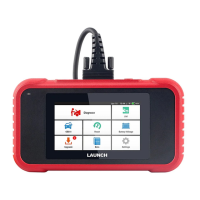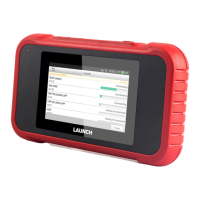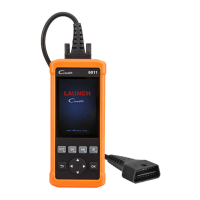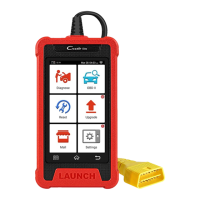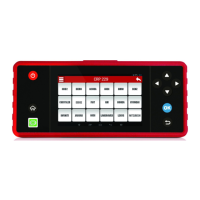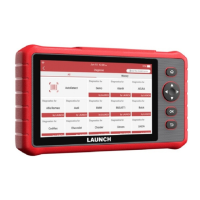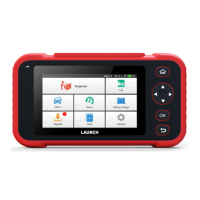
Do you have a question about the Launch Creader Professional 129i and is the answer not in the manual?
| Brand | Launch |
|---|---|
| Model | Creader Professional 129i |
| Category | Diagnostic Equipment |
| Language | English |
Sets measurement units like Metric and English.
Enables automatic VIN detection upon connecting to the vehicle's DLC.
Adjusts standby time and screen brightness for power saving.
Allows adjustment of volume and other sound settings.
Manages WLAN connections for online services like registration and updates.
Sets the system date and time for accurate report sorting.
Explains the OBD II system, its purpose, and warning indicators.
Details the structure and meaning of OBD II Diagnostic Trouble Codes.
Guides on finding the vehicle's Data Link Connector (DLC) for diagnostics.
Explains the function of Readiness Monitors in the OBD II system.
Describes how monitors are set to "Ready" or "Not Ready" and factors affecting status.
Provides definitions for key OBD II terms like PCM and MIL.
Details the external appearance and components of various Creader Professional models.
Lists the technical specifications of the diagnostic tool, including screen, RAM, and battery.
Lists the standard accessories included with the Creader Professional tool.
Explains the methods for charging the diagnostic tool.
Guides through initial setup steps like language and network configuration.
Describes the main function modules available in the Job Menu for diagnostics.
Instructions for connecting the tool to the vehicle's DLC for diagnosis.
Details the process of diagnosing vehicle electronic control systems.
Explains the automatic vehicle detection and scanning process.
Guides on performing vehicle diagnosis manually when VIN detection fails.
Generates a detailed report of the vehicle's electronic control units (ECUs).
Allows manual selection of test systems and functions for diagnosis.
Reads system mode, vehicle VIN, software, and ECU version information.
Displays detailed diagnostic trouble codes (DTCs) and related troubleshooting information.
Erases retrieved DTCs from the vehicle's ECU after repairs are made.
Provides quick access to check DTCs, monitor status, and perform emission-related services.
Identifies sections of the emission control system that have malfunctioned.
Erases trouble codes from the vehicle's system after repairs.
Checks if emissions-related systems are operating properly and ready for testing.
Retrieves and displays live data and parameters from the vehicle's ECU.
Captures snapshot of operating conditions when an emission-related fault occurs.
Displays results of the ECU's last O2 sensor test.
Reads results of on-board diagnostic monitoring tests for specific components.
Initiates a leak test for the vehicle's EVAP system.
Displays vehicle information like VIN, CID, and CVN.
Provides access to previously tested vehicles and diagnostic session details.
Performs common maintenance resets like oil lamp and parking brake resets.
Stores and allows viewing/searching of all generated diagnostic reports.
Saves and plays back recorded running parameters or waveform graphs.
Helps find definitions for Diagnostic Trouble Codes (DTCs).
Assists in locating the vehicle's Data Link Connector (DLC).
Allows users to submit diagnostic problems for analysis and troubleshooting.
Sets measurement units like Metric and English.
Enables automatic VIN detection upon connecting to the vehicle's DLC.
Adjusts standby time and screen brightness for power saving.
Allows adjustment of volume and other sound settings.
Manages WLAN connections for online services like registration and updates.
Sets the system date and time for accurate report sorting.
Supports changing the tool's display language.
Configures the default email for receiving diagnostic reports.
Resets the tool to its default factory settings, warning of data loss.
Clears cache files to free up storage space on the tool.
Displays hardware configuration and license agreement information.
